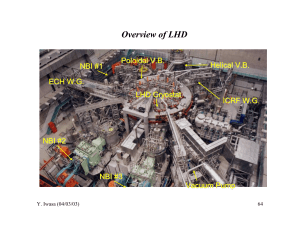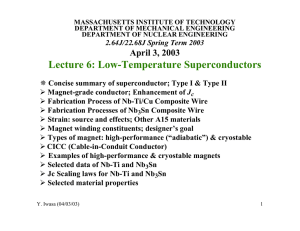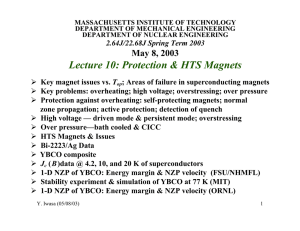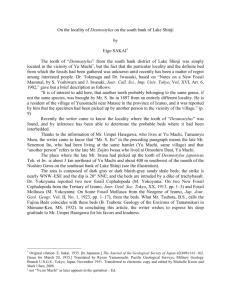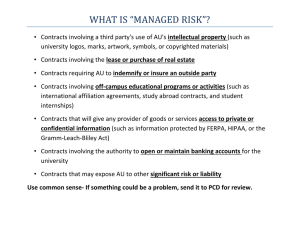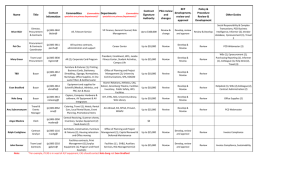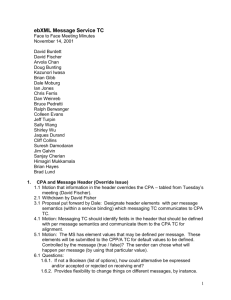MASSACHUSETTS INSTITUTE OF TECHNOLOGY DEPARTMENT OF MECHANICAL ENGINEERING DEPARTMENT OF NUCLEAR ENGINEERING
advertisement
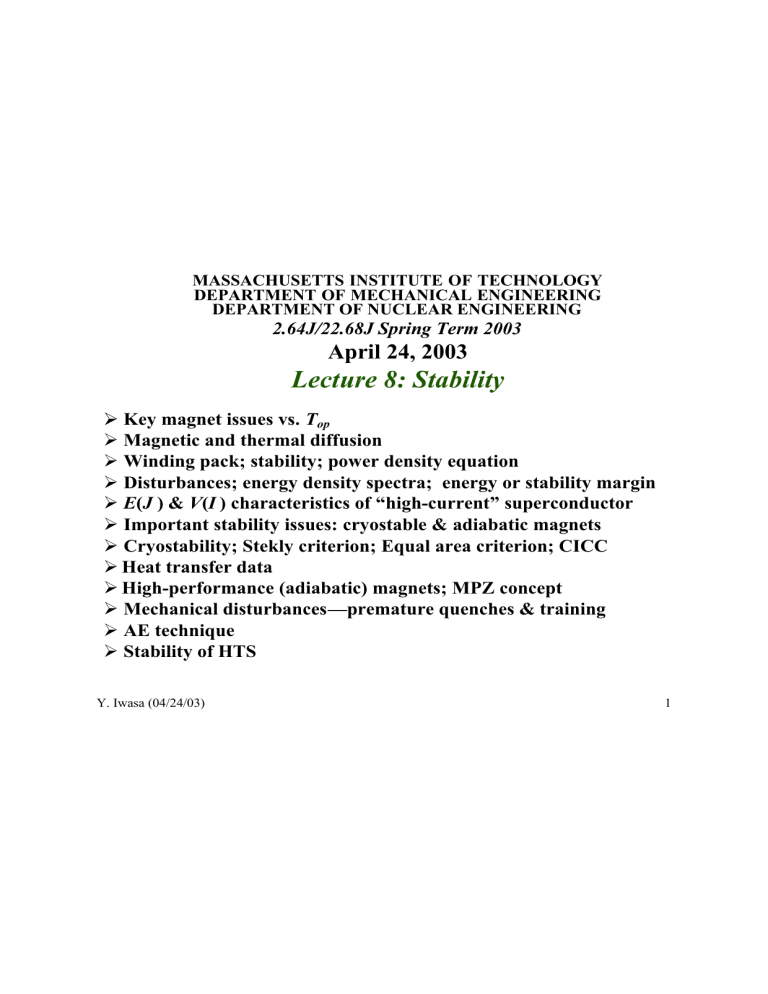
MASSACHUSETTS INSTITUTE OF TECHNOLOGY DEPARTMENT OF MECHANICAL ENGINEERING DEPARTMENT OF NUCLEAR ENGINEERING 2.64J/22.68J Spring Term 2003 April 24, 2003 Lecture 8: Stability Key magnet issues vs. Top � Magnetic and thermal diffusion � Winding pack; stability; power density equation � Disturbances; energy density spectra; energy or stability margin � E(J ) & V(I ) characteristics of “high-current” superconductor � Important stability issues: cryostable & adiabatic magnets � Cryostability; Stekly criterion; Equal area criterion; CICC � Heat transfer data � High-performance (adiabatic) magnets; MPZ concept � Mechanical disturbances—premature quenches & training � AE technique � Stability of HTS Y. Iwasa (04/24/03) 1 Key Magnet Issues vs Top Cost or Difficulty Protection Conductor Mechanical Stability Cryogenics 0 ~100 LTS Y. Iwasa (04/24/03) Top [K] HTS 2 Magnetic Diffusion r H r Jf r B t r E 2 e Hy x 2 e 0 Dmg ( 1 -D) Hy x Hy 2 x e By 0 t e 0 2 Dmg Hy t Dmg t Ez Jz Ez x 0 2 Hy Hy x Hy 2 t mg 1 2a Dmg 2 0 2a 2 e e 0 mg 1 2a Dmg Y. Iwasa (04/24/03) 2 0 2a 2 e 3 Thermal Diffusion 2 k T 2 x C T t 2 k T C x2 2 Dth T 2 x Dth k C Y. Iwasa (04/24/03) T t 4 Data for Cu & Nb-Ti K [W/m K] C [J/m3K] Copper ~400 ~1000 Nb-Ti ~10-3 ~500 Dth Cu Dth SC Dmg Cu Dm g SC ~ 2 105 ~ 6 10 3 Dth [m2/s] Dmg [m2/s] ~3 10-10 ~0.4 ~3 10-3 ~5 10-7 ~2 10-6 ~0.5 [ m] Temperature wave travels much faster in Cu—no temperature concentration in Cu. Magnetic wave travels much slowly in Cu—no flux motion induced local heating concentration in Cu. Best to use Nb-Ti with Cu Y. Iwasa (04/24/03) 5 Winding Pack Structure Awpk Astr Acs Am Ains Aq Coolant Conductor Ins. Matrix SC Coolant Insulation Superstructure Matrix (e.g. Cu) Superconductor Structure (e.g. epoxy, conduit) Winding Pack Cross Section Y. Iwasa (04/24/03) 6 Jc Ic Asc Ic JnonCu Ac d Am Jc Jeng Je Jm Iop Am Joverall Y. Iwasa (04/24/03) (Nb 3Sn; HTS) (Nb - Ti) Ic Acd (Qunech propagation &protection) I op Awpk 7 Stability Stability of a superconducting magnet refers to the phenomenon of the magnet to operate reliably despite the presence of disturbance events. Tcd limit set by design Disturbance may be mechanical, electromagnetic, thermal, or even nuclear in origin. Distributed: energy density [J/m 3] Point: energy [J] Y. Iwasa (04/24/03) 8 Power Density [W/m3] Equation e h gk g j gd gq (6.1) Cooling: f p Pcd Acd q (T ) Disturbance: gd Joule heating: Conduction: cd (T )J cd2 kcd (T ) T T Storage: Ccd (T ) t Ccd (T ) T t Y. Iwasa (04/24/03) x kc d(T ) T x 2 cd (T )Jcd x gd kcd (T ) T x f p Pcd q (T ) Acd 9 Stability Concepts Derived from Eq. 6.1 ėh gk gj 0 0 ** 0 Application Flux jump Cryostability * 0 Dynamic stability 0 0 “Equal area” * 0 0 0 MPZ * 0 0 Protection 0 0 Adiabatic NZP * * 0 0 † gq 0 0 * gd † Covered in today’s lecture Minimum Propagation Zone Normal Zone Propagation Y. Iwasa (04/24/03) 10 Sources of Disturbance Mechanical—Lorentz force; thermal contraction Wire motion/”micro-slip” Structure deformation Cracking epoxy; debonding Electrical/Magnetic —Time-varying current/field Current transients, includes AC current Field transients, includes AC field Flux motion, e.g., flux jump Thermal Conduction, through leads Cooling blockage (poor ventilation) Nuclear radiation Neutron flux in fusion machines Particle showers in accelerators Y. Iwasa (04/24/03) 11 Disturbance Energy Density Spectra Courtesy of Luca Bottura (CERN, Geneva) Y. Iwasa (04/24/03) 12 Energy Margin or Stability Margin: eh; emin Minimum energy density (or energy) that leads to a quench Disturbance energy < Disturbance eh T < Tcs Disturbance energy > T t T t <0 Stable >0 Quench T > Tcs T Not-stabilized Y. Iwasa (04/24/03) Stable eh Stabilized Disturbance <0 t 13 E(J) & V(I) Characteristics of “High-Current” Superconductor E(J ) J Ec Jc n I V ( I ) Vc Ic n n: “Index” of a superconductor: “ideal” superconductor, n= E( J ) n n1 n2 Ec Jc Y. Iwasa (04/24/03) J 14 Typical Values of n for “Magnet-Grade” Conductors Nb-Ti: 20--100 (50--100 for NMR/MRI persistent-mode magnets) Nb3Sn: 20--80 (40--80 for NMR/MRI persistent-mode magnets) BSCCO2223: 10--25 Y. Iwasa (04/24/03) 15 Important Stability Issues—Cryostable & Adiabatic Magnets Cryostable Magnets Circuit model for a well-cooled composite conductor. “Current-sharing.” Cryostability (Stekly)—“linear”cooling. Cryostability—nonlinear cooling. “Equal Area” stability. CICC Cooling data—bath & forced-flow. Adiabatic Magnets Premature quenches; training. Minimum propagation zone (MPZ). Disturbance spectra. Acoustic emission (AE) technique. Y. Iwasa (04/24/03) 16 Cryostable Magnets Coolant—bath; CCIC;pipe Matrix normal metal Normal zone size >> “MPZ;” in bath-cooled magnets, can extend over the entire magnet volume. Best design: sufficient cooling with the minimum coolant space. Y. Iwasa (04/24/03) 17 Adiabatic Magnets Structural material, e.g., epoxy Matrix normal metal “Localized” normal zone permitted, but its size < “MPZ” (~mm in most windings). Best design: elimination of all disturbances. Y. Iwasa (04/24/03) 18 Cryostability Circuit Model for Ideal Superconductor (n = Vcd 0 Gj Vcd It Ic 0 o Rs + Vcd – o Real Ideal ( n= Rn )— It ) I Ic n Im=0 It Ic Matrix Rm It Ic= It 0 Y. Iwasa (04/24/03) Ic Is Superconductor Rs 19 Cryostability Circuit Model for Ideal Superconductor (n = Vcd Rm Im Rs Rm Gj Vcd It Gj Rm It (I t It Ic Rm ( It Ic ) Rs Ic At Ic , superconductor will have Rs between 0 and Rn >> Rm to satisfy the circuit requirements 1 Ic ) o Rs + Vcd – o Real Ideal ( n= Rn )— It ≥ Ic ) I Ic n Im It > Ic Matrix Rm Ic 0 Y. Iwasa (04/24/03) Ic Is Superconductor Rs 20 Temperature Dependent G j(T )—Stekly Model It I c (Top ) Ic 0 Ideal superconductor (n = ) Ic (T ) Gj (T ) It=Ic0 RmIt2 It – Ic Current-sharing Ic 0 Top=Tcs Y. Iwasa (04/24/03) Tc T 0 Top=Tcs Tc 21 Cryostability—Stekly Criterion T Tcs Tc Tcs 2 G j (T ) Rm It Gq (T ) f p Pcd hq (T gq (T ) f p Pcd hq (T Top ) Acd f p Pcd hq (T m Note: Tb Top Ic20 T Top I sk f p Pcd Am hq ( Tc Top ) 1 2 m c0 sk m I I c0 Acd Y. Iwasa (04/24/03) J c0 Ic 0 As Am I c20 (6.8) Note that the conventional definition of sk is upside down of Eq. 6.8 2 m c0 f p Pcd hq (Tc Top ) cd Tc ) Acd Am Tc Top f p Pcd Am hq (Tc Top ) J c0 T Tb ) Top ) Acd Am (Tcs 1 s c/s 22 Stekly (continued) 2 Dissipation: Power density m I m I c0 T Top Acd Am Tc Top Cooling: f p Pcd hq (T Top ) Acd Not stable 2 c0 Acd Am Stable 0 Top Tb Y. Iwasa (04/24/03) T T < Tc 23 General Case ( It < Ic0 or Tcs > Top ) G j (T ) 0 G j (T ) Ic 0 Rm It It It Ic 0 Tc T Tc Top Tc Top G j (T ) Tc Tcs Rm I t Ic(T ) 2 T Tcs Tc Tcs (Top T Tcs ) (Tcs T Tc ) (Tc s T Tc ) Gj(T ) Superconductor Ic0 Current-sharing RmIt2 It Matrix T Top Tcs Y. Iwasa (04/24/03) Tc Top Tcs Tc T 24 Nonlinear Cooling Curves [J c 0 ]cd [Jt ]cd [J op ]cd f p Pc dAm q fm Am )2 m (As f p Pcd q f m m Am [A/m3 ] q(T ), gj(T ) qpk qfm q(T ) Stekly gj General Top Tb Tcs Y. Iwasa (04/24/03) I2 f p Pcd Am m t [w/m2 ] T Tc 25 Example fp 0.5; Pc d = 2.6 c m ; Am As Acd 2 Am Acd = 0.273 cm ; 1 f p Pcd Am q fm Am ) 2 m ( As [J op ]cd m 2 0.3 cm ; 3 10 -8 Am As cm; q fm = 10; 2 0.3 W/cm ; (0.5)(2.6cm)(0.273 cm2 )(0.3 W/cm 2 ) ( 3 10 -8 cm)(0.3cm2 )2 2 6280 A/cm [J op ]s (1 )[J op ]cd 2 69,080 A/cm LHe Iop Acd [J op ]cd 1884 A ( = 10) Iop Acd [J op ]cd 1803 A Y. Iwasa (04/24/03) 10 mm ( = 5) 3 mm 26 V vs. I Traces of a Composite Conductor Matrix alone at T = Tb SC alone at T = Tb V V Rs >> Rm Rm 0 Ic0 0 I 0 0 I Rs / Rm ~1000-10000 Y. Iwasa (04/24/03) 27 V vs. I Traces of a Composite Conductor G j (Top T ) VI f p Pcdlhq (T Top ) T V Rm I ( I Rm I Tc (Top T) Tc Top I Rm I ( I Ic 0 ) Ic0 T Tc Top f p Pcdlhq T I c0 )(Tc Top ) f d Pcd lhq (Tc Top ) Rm ( I I c0 Ic 0 ) Rm Ic 0 I I c0 Tc Top Rm I ( I I c 0 )(Tc Top ) f p Pcd lhq (Tc Top ) Rm Ic0 I 2 Rm ( I Ic0 ) Y. Iwasa (04/24/03) Rm I ( I Ic0 )(Tc Top ) f p Pcdlhq (Tc Top ) Rm I c0 I 28 V vs. I Traces: Dimensionless Expressions v V Rm Ic 0 i I Ic0 sk f p Pcd lhq (Tc Top ) Rm I c20 v( i) ( i 1) i( v) sk (v sk Y. Iwasa (04/24/03) i( i 1) i sk f p Pcd Am hq (Tc Top ) 2 m Ic 0 sk ( i 1) i sk 1) v 29 Numerical Illustrations Ic 0 5 2 1 0 0 0 A ;Tc 5.2 K ; Top 4.2 K; Am 2 10 m ; m = 4 10 -10 m; hq = 104 W/m2 ; Pcd= 2 10-2 m2 fm=1: Entire conductor surface exposed to coolant sk (1)(2 10 2 m)(2 10 -5 m2 )(10 4 W/m 2 K)(5.2 K - 4.2 K) (4 10 -10 m)(1000 A) 2 10 v 1 v vs. i for sk = 10 i 1 1.1 v 0 0.11 0.59 1.5 2 T 1.25 0 0 Y. Iwasa (04/24/03) 1 Tb i 30 Numerical Illustrations fm=0.1: 10% of conductor surface exposed to coolant sk (0.1)(2 10 2 m)(2 10 -5 m2 )(10 4 W/m 2 K)(5.2 K - 4.2 K) (4 10-10 m)(1000 A) 2 1 v 1 0 0 Y. Iwasa (04/24/03) 1 i 31 Numerical Illustrations fm=0.05: Only 5% of conductor surface exposed to coolant v vs. i for sk = 0.5 v 0 0.125 0.25 0.5 0.625 0.707 i 1 0.9 0.833 0.75 0.722 0.707 v i 0.5( i 1) 0.5 i or v i v 0.707 0.5 0.5(v 1) 0.5 v 1 0 0 Y. Iwasa (04/24/03) 0.707 1 i 32 Y. Iwasa (04/24/03) 33 “Equal-Area” Criterion 0 gk (T ) g j (T ) 0 g q (T ) gk (T ) d dT kcd (T ) dx dx gq (T ) g j (T ) S (T ) kcd (T ) dT dx dS(T ) dS(T ) dT dS(T ) S (T ) gq (T ) g j (T ) dx dT dx dT kcd (T ) dS(T ) S(T ) kcd (T ) gq (T ) g j (T ) dT T2 1 2 S (T2 ) S 2 (T1 ) k0 T gq (T ) g j (T ) dT 1 2 S(T1 ) S (T2 ) 0because dT/ dx x T2 T1 Y. Iwasa (04/24/03) gq (T ) 1 dT/ dx x g j (T ) dT 0 2 0 34 Equal Area (continued) 2-D Case kcd (T ) T d dT kcd (T ) dr dr dT d kcd (T ) dr dr gq (T ) g j (T ) dT 1 kcd (T ) dr r dT 1 kcd (T ) dr r Because the last term dT/dr is negative, it has the same effect as that of increasing cooling or decreasing Joule heating. Y. Iwasa (04/24/03) 35 q(T ), gj(T ) qpk q(T ) Equal Area qfm Stekly gj 2 m c0 I f p Pcd Am Stekly (Tcs>Top) Top Tb Tcs Tc T [Ic0]equal area > [Ic0]Stekly Y. Iwasa (04/24/03) 36 Recovery Processes “Stekly” T x T “Equal Area” x Y. Iwasa (04/24/03) 37 CICC Transposed 37-Strand Cable (c. 1970) Courtesy of Luca Bottura (CERN, Geneva) Y. Iwasa (04/24/03) 38 Power Density Equation—CICC Conduit Fluid Composite Vfl(T ) Ccd (T ) T t x C fl (T ) T fl t f p Pcd q (T ) A fl hfl kc d(T ) T x cd f p Pc d h fl Af l k T 0.0259 f l Re 0.8 Pr 0.4 fl Dhy T Y. Iwasa (04/24/03) (T )J cd2 (T gd f p Pcd q(T ) Acd T fl ) 0.716 39 Stability Margin vs. Current in CICC eh [mJ/cm3] Well-Cooled ~1000 Dual Stability* Ill-Cooled ~100 ~10 0 Ilim Iop * J.W. Lue, J.R. Miller, L. Dresner (J. Appl. Phys. Vol. 51, 1980) Y. Iwasa (04/24/03) 40 Stability Approach for CICC Because CICC is mostly applied for “large” (“expensive”) magnets, cryostability (Stekly) is the accepted approach. Choose Iop Ilim given by: I lim f p Pcd Am hq (Tc Top ) m Y. Iwasa (04/24/03) 41 Helium Heat Transfer Data—Nucleate & Film Boiling 10 Approximate N2 data multiply: qpk q(T ) [W/cm2] 1 y-scale by 10-30 x-scale by 10 0.1 qfm 0.01 0.001 0.01 0.1 1 10 100 T [K] Based on data from Luca Bottura (CERN, Geneva) Y. Iwasa (04/24/03) 42 Helium Heat Transfer Coefficient Data hq(T ) [W/cm2] 10 qpk 1 0.1 0.01 0.01 0.1 1 10 100 T [K] Based on data from Luca Bottura (CERN, Geneva) Y. Iwasa (04/24/03) 43 Computation of Ilim for ITER CS (Central Solenoid) CICC Strand dia. (dst ) 0.81 mm Cu/non-Cu (γ) 1.45 Cable 3×4 ×4 ×4 ×4 # Strands (Nst ) 1152 Am = Acu 3.51 ×10−4 m2 fp 5/6 Pcd = Pst 2.93 m hq 600 W/m2 K Tc (13 T); Tb 11.2 K; 4.5 K m Acu (13 T) dst2 N st 4 Y. Iwasa (04/24/03) 6.8×10−10 Ω m 1 Pst dst N st 44 Ilim (5/6)(2.93 m)(3.51 10-4 m2 )(600 W/m2 K)(11.2 K - 4.5 K) 6.8 10 -10 m) 71kA Iop (40 - 46 kA) < I lim Ic (96 kA) This CICC design as with CICC designs for the rest of ITER coils are highly stable, i.e. very conservative. Y. Iwasa (04/24/03) 45 High-Performance (“Adiabatic”) Magnet Jover enhanced by: Combining superconductor and high-strength normal metal (stability; protection; mechanical). Eliminating local coolant* and impregnating the entire winding space unoccupied by conductor with epoxy, making the entire winding as one monolithic structural entity. (Presence of cooling in the winding makes the winding mechanically weak and takes up the conductor space.) High-performance approach universally used for NMR, MRI, HEP dipoles & quadrupoles in which R J B manageable with a combination of “composite conductor” & “monolithic entity.” * The conductor always requires cooling but not necessarily exposed directly to the coolant. Y. Iwasa (04/24/03) 46 MPZ Concept* Even in an adiabatic magnet, a small normal-state region may remain stable: gj is balance by thermal conduction to the outside region. Corollary: Even an adiabatic magnet can tolerate a disturbance without being driven to a quench How large is this normal state region, Rmz , and a permissible disturbance energy? y Region 1 Region 2 ( r> Rmz) Rmz x * A.P. Martinelli, S.L. Wipf (IEEE, 1971) Y. Iwasa (04/24/03) 47 0 gk gj 0 0 kwd d 2 d T1 r dr r 2 dr gj kwd d 2 d T2 r r 2 dr dr gj (Region 1) 0 (Region 2) C A B; T2 ( r ) r r 6kwd Boundary conditions: At r , T2 Top D Top ; r 0, T1 T1 (r ) dT1 dr r At r Rmz r2 g j Rm g 3kwd Rm z, T1 T2 dT2 dr C 2 Rmz r R mz T1 (r ) A 0; r C gj r 2 B ; T2 (r ) 6kwd 2 T1 (r ) Top Y. Iwasa (04/24/03) D g j Rm z 1 2kwd Rm z, dT1 / d r dT2 / dr : 3 g j Rmz 3kwd Top 3 g j Rmz 3kwd r 1 r 3 Rm z B Top 2 g j Rmz 2kwd 2 48 Total Joule Heating G j Gj 3 4 pRmz gj 3 Because g j Tc Top 4 pRm3 z dT kwd 1 3 dr m J m2 and T1 2 m z wd 4 pR k r Rmz Tc at r 2 g j Rmz 2kwd 2 3Rmz 4 Rm3 z gj 3 Rmz : 2 J m2 Rmz 3kwd m 3kwd (Tc Top ) Rm z m With kwd 400W/mK;Tc 6K; Top Jm2 4K; Rmz 1 3(400W/mK)(6K - 4 K ) ( 2 10 10 m)(300 106 A/m2 ) Rmz 2 kwd 2 R kwd 1 mz 1 Y. Iwasa (04/24/03) 0.1W/mK R 400W/mK mz 1 m 2 10 10 m; J m 6 2 300 10 A/m : 12mm 0.2mm 49 With kwd 400 W/mK; Tc 6 K ;Top 4K; Rmz 1 3(400W/m K)(6K- 4K) ( 2 10 10 m)(300 106 A/m2 ) Rmz 2 kwd 2 R kwd 1 mz 1 0.1W/m K R 400W/m K mz 1 m 2 10 10 m; J m 300 10 6 A/m2 : 12mm 0.2mm 2Rm z2 2Rm z1 Y. Iwasa (04/24/03) 50 Energy margin or stability margin, Eh : Tc Eh mz With Rmz 2 and h(Top ) mz T op Cwd (T )dT 4 2 10 m, Rmz 1 2 4 Rmz 2 Rm z1 h(Tc ) 3 cu 3 2 1.2 10 m, h(Tc ) cu 3.9kJ/m , 3 cu 1.3kJ/m : 4 ( 2 10 4 m)2( 1 . 2 10 2 m) 3 Y. Iwasa (04/24/03) h(Top ) 9 3 2 10 m Eh 5.2 10 6 J ~ 10 J eh 2.6kJ/m3 2.6mJ/cm3 51 Cryostable vs. Adiabatic (High-Performance ) Magnets Basic power density equation: e• h gk gj gd gq Cryostable Magnets • eh 0; gk Jc0 Y. Iwasa (04/24/03) gj ; gd gj gj f p Pcd Am q fm cd m ( As Am ) gq Jc 0 s 52 Cryostable Magnets (continued) Observations [Jc0]cd determined by external parameters. Applied for “large magnets” (e.g. fusion) in which non-conducting structural materials occupy a significant fraction of the winding pack, making the condition [Jc0]cd << [Jc0]s not as important as in adiabatic magnets. Note that coolant, though a key component in a cryostable magnet, is a structural detriment. Y. Iwasa (04/24/03) 53 Adiabatic (High-Performance) Magnets • eh gk gj gd gq 0 Observations Elimination of coolant within the winding: 1) enhances the overall current density; 2) makes the winding pack structurally robust. [Jc0]cd no longer limited by external parameters but primarily by [Jc0]s . Disturbances (gd) must be eradicated or their energies minimized— impregnation of the winding with epoxy resin a widely used technique. High-performance magnets: NMR, MRI, HEP. Y. Iwasa (04/24/03) 54 Mechanical Disturbances—Premature Quenches & Training Important for adiabatic magnets; not so for cryostable magnets. Through the use of AE (acoustic emission) technique, it has been demonstrated that virtually every premature quench in adiabatic magnets is induced by a mechanical event, primarily either conductor motion or epoxy fracture. Mechanical events usually obey the “Kaiser effect,” mechanical behavior in cyclic loading in which mechanical disturbances, e.g., conductor motion, epoxy fracture, appear only when the loading responsible for events exceeds the maximum level achieved in the previous loading sequence. An adiabatic magnet thus generally “trains” and improves its performance progressively to the point where it finally reaches its design operating current. Y. Iwasa (04/24/03) 55 Training Sequence for an SSC Dipole S. Ige (MIT ME Dept. Ph.D. Thesis, 1989) Y. Iwasa (04/24/03) 56 AE Technique Acoustic signals emitted by sudden mechanical events in a body being loaded or unloaded, e.g., a magnet being charged or discharged; useful for detection and location of a premature quench caused by conductor motion or epoxy fracture event in adiabatic magnets. Piezoelectric Effect The coupling of mechanical and electric effects in which a strain in a certain class of crystals, e.g. quartz, induces an electric potential and vice versa. Discovered by P. Curie in 1880. Y. Iwasa (04/24/03) 57 AE Sensor Commercially available sensor: expensive ($500-$1000) and even those claimed to be for use in “low temperatures” generally fail. Home-made (FBML) differential sensor: reasonable ($50/disk + labor); withstands 4.2 K RT cycles. Differential Sensor from Copper pipe cap Sensor: two half-disks +– – + Y. Iwasa (04/24/03) Cu foil (~25 m) Brass foil (~75 m) 58 AE Instrumentation LabVIEW Oscilloscope AE Sensor Filter 10k–1MHz Pre-amp e.g. 40 dB Filter 200k–230kHz Amplifier e.g. 43 dB Discriminator <0.1 V Counter Recorder Y. Iwasa (04/24/03) 59 Identification of Quench Causes A combination of voltage and AE monitoring permits identification of three distinguished causes of a quench in adiabatic magnets. Conductor motion: a voltage spike and the start of AE signals. Epoxy fracture: no voltage spike but AE signals. Critical current: no voltage spike nor AE signals. Y. Iwasa (04/24/03) 60 Epoxy cracking Three Causes of Quench NO voltage pulse AE Conductor-motion Critical current Voltage pulse AE O. Tsukamoto, J.F. Maguire, E.S. Bobrov, Y. Iwasa (Appl. Phys. Lett. Vol. 39, 1981) Y. Iwasa (04/24/03) 61 A Conductor-Motion Induced Quench — “Isabella” Dipole AE AE 5 ms 50 ms V O. Tsukamoto, M.F. Steinhoff, Y. Iwasa (IEEE, 1981) Y. Iwasa (04/24/03) 62 Conductor-Motion Induced & Critical-Current Quenches — An SSC Dipole Located farthest from the source Due to heating AE AE AE NO AE signals! Voltage Voltage Voltage scale too large for a spike Iq = 6510 A Ic = 6828 A S. Ige (MIT ME Dept. Ph.D. Thesis, 1989) Y. Iwasa (04/24/03) 63 Conductor Motion Frictional heating energy release, ef , due to a Lorentz-force induced conductor motion (“slip”) of rf : ef With f f fL r rf 0.3, J f J Bz rf 6 2 200 10 A/m , Bz 5T, ande f hcu (5.2K) - hcu (4.2K) = 1300J/m 3 : rf ef f J Bz 3 (1300J/m ) 20 m (0.3)(200 106 A/m2 ) ( 5 T ) Actually a conductor slip as small as ~1 m (“microslip”) can drive a short length of the conductor to the normal state, leading to a premature quench. Y. Iwasa (04/24/03) 64 Friction/Quench Experiment Ft AE Sensor Fn B (5 T) G705 Fn Fn Ft I AE Sensor Search Coil Conductor Braid I Ft I B Fn Helmholtz Coil Based on O. Tsukamoto, H.Maeda, Y. Iwasa (Appl. Phys. Lett. Vol. 40, 1982) Y. Iwasa (04/24/03) 65 Slip Distance from Extensionmeter V (t ) z d dNAB dt dt V ( t ) dt NA dB dz dz dt B(z ) mea dB NA dz V(t ) known V(t ) Slip Distance from Voltage Pulse V (t ) z d lzB d dt dt V ( t ) dt mea lB Y. Iwasa (04/24/03) known z (t ) Search coil (N, A) lB dz dt Ft ; z I l B 66 Friction Experiment Quench Experiment Slip-Induced voltage spike Search Coil 2 mV AE 1 ms Slip distance: ~1 m Peak slip velocity: ~ 1 cm/s Fn=2000 N; Ft~400 N Slip distance: ~1 m Peak slip velocity: ~ 3 cm/s Fn=2000 N; Ft=500 N [=(0.025 m)(4000 A)(5 T)] Y. Iwasa (04/24/03) 67 Observation of Kaiser Effect Friction Experiment Quench Experiment H. Maeda, O. Tsukamoto, Y. Iwasa (Cryogenics Vol. 22, 1982) Y. Iwasa (04/24/03) 68 Y. Iwasa (04/24/03) 69 Epoxy Cracking Inducted Heating Stored elastic energy density, eel, typical epoxy resin: e el 2 el 2 Ee l (15 10 6 Pa) 2 2(10x109 ) 2 3 1100J/m ef Nb-Ti/Cu composite Epoxy coating Y. Iwasa (04/24/03) 70 Epoxy Cracking Inducted Heating — Experimental Results T1 Ft T2 T1 Nb-Ti/Cu composite max T2 T3 Epoxy coating 1K T4 max T3 AE Sensor AE T4 0 from Y. Yasaka, Y. Iwasa (Cryogenics Vol. 24, 1984) Y. Iwasa (04/24/03) 50 100 150 200 Time [ms] 71 Stability of HTS Operating Temperature Ranges 0 ~10 LTS ~100 Top [K] HTS [Tcs – Top]HTS > ~10 [Tcs – Top]LTS Y. Iwasa (04/24/03) 72 Heat Capacity Data [C p (Top Range)]H T S [C p (TopRange)] L T S A. B. C. D. E. F. G. H. I. 1 Helium (10 atm) Helium (1 atm) GE varnish Stainless steel Nb-Ti Epoxy Silver Copper Aluminum Y. Iwasa (04/24/03) 73 Enthalpy Data [e min ]H T S [e min ]LTS 1 1. Silver 2. Copper 3. Aluminum Y. Iwasa (04/24/03) 74 Minimum Thermal Energy Density — Cp(T): copper; Tc: Superconductor— Top+∆T e min e = ∫T Top min Y. Iwasa (04/24/03) op T op C pT(TC)dT( T ) d T op cd 75 HTS Stability >> LTS Stability Y. Iwasa (04/24/03) 76
